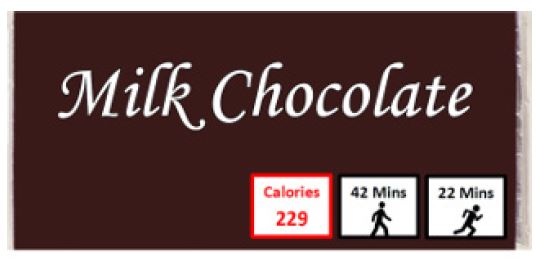Friends and colleagues, yes – I am being provocative in the title of this blog (skip down to check out my bottom line).
In our societal battle against obesity, one of the tactics that has been examined to help inform food choices is to label food with the amount of activity required to burn off those calories. For example, as pictured above, this milk chocolate contains 229 calories, which the label says would require 42 minutes to walk off, or 22 mins to run off. This is called PACE (physical activity calorie equivalent) labeling.
The question is: does PACE labeling actually work?
A systematic review recently assessed available data on this topic. The authors analyzed 15 studies comparing PACE food labeling with any other type of food labeling, or no labeling, as the comparator. They found that when PACE labeling was displayed on food/drinks and menus, participants ordered 65 calories less, and consumed 80 calories less, than those who were ordering from the non-PACE menu.
So is the PACE labeling approach actually useful in real life? On the pro side, it could help people understand how much energy a food contains, and may give pause to make us consider whether a certain food is ‘worth it’ when we are ordering or eating. It could also be a good reminder of the importance of staying physically active.
HOWEVER, I see a number of faults in this approach:
- The number of calories that one person burns with activity can be hugely different compared to the next person. (varying by weight, gender, body composition, age and so forth)
- The number of calories burned with an activity like walking or running is also hugely dependent on how fast or intensely a person chooses to walk or run.
- We should not be promoting activity as a reason to ‘get to eat’ something. In fact, the vast majority of calories we burn are at rest, not with activity.
- A reduction in 80 calories of food intake could help to prevent weight gain, but won’t do a whole lot for weight loss. And does that person who eats 80 calories less off the menu at lunch have more for dinner? The studies don’t answer that question.
- Does PACE labeling result in an increase in physical activity? The studies don’t answer that question either.
Most importantly: Weight management is NOT about ‘eat less and move more’. It’s about learning about changing thought processes and the way we think about food, how we problem solve challenging situations in our day, how we cope with stress, refocusing on health and not body size – and the outcome of these changes is healthier food and activity choices.
Share this blog post using your favorite social media link below!
Follow me on twitter! @drsuepedersen
www.drsue.ca © 2020












